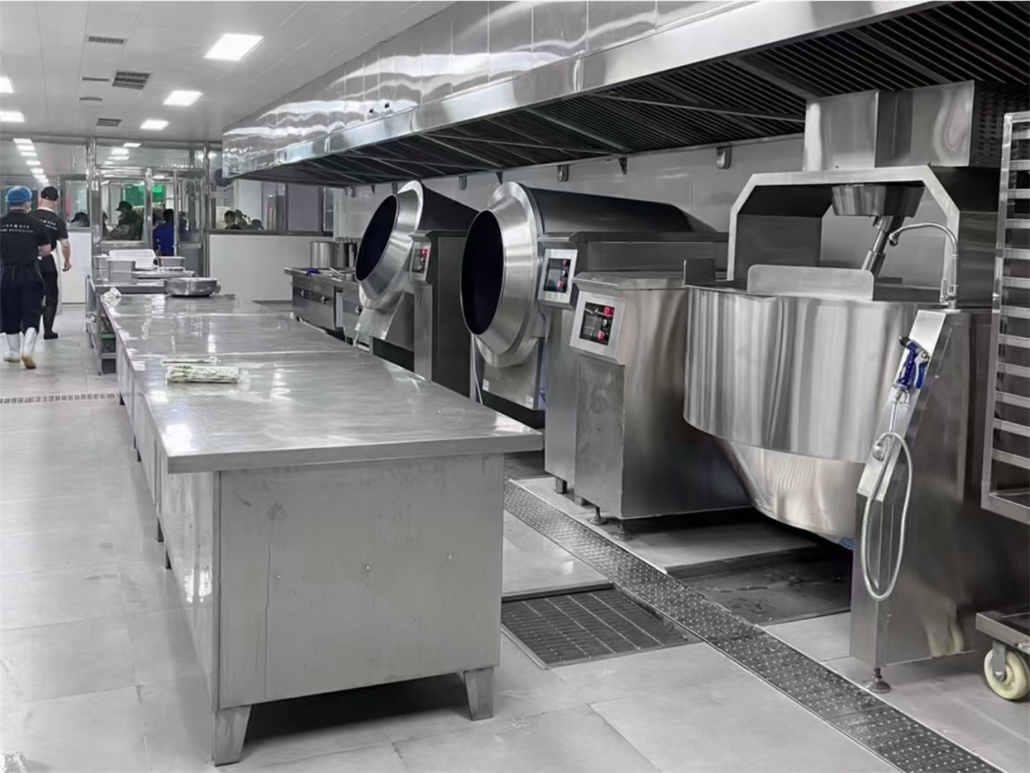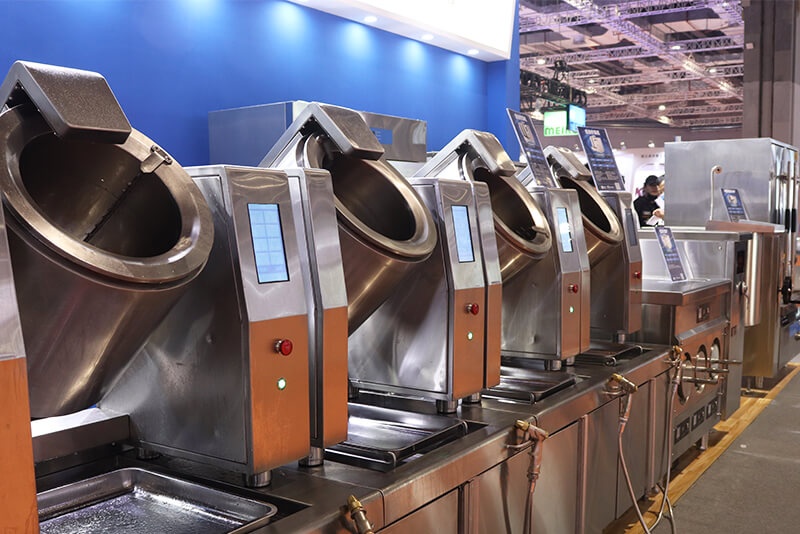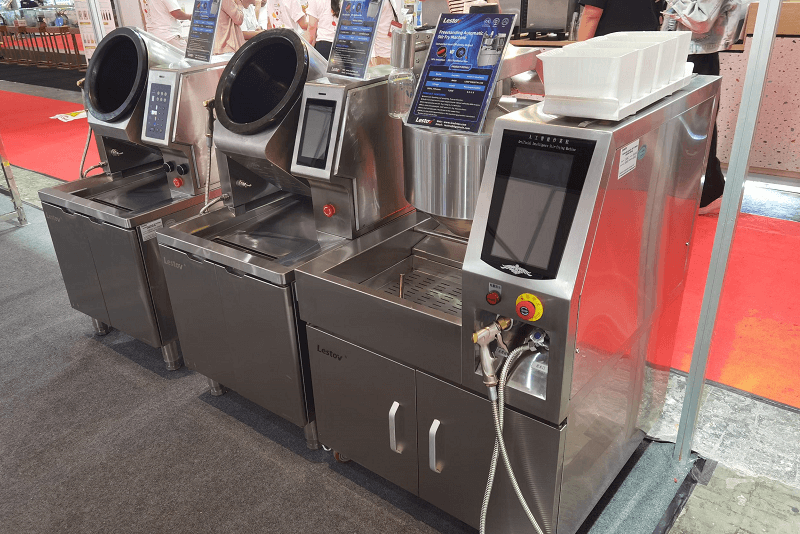As an efficient cooking device in modern kitchens, automatic cooking machines have been designed and…

Automatic Cooking Machine – Changes and responses of Catering Industry
Against the backdrop of artificial intelligence and automation technology sweeping the world, the catering industry is undergoing a profound transformation. Mașini automate de gătit have rapidly occupied the market with the advantages of high efficiency, low-cost, and standardized products.
However, will automated cooking technology completely replace chefs? How should chefs respond? How should restaurant owners balance human-machine collaboration? This article will explore this series of issues from the perspective of manufacturers, combining the current status of the industry with future trends.
I. Can mașini automate de gătit replace chefs?
1. From a technical perspective
Automatic cooking machines have made significant technological progress and can achieve a variety of cooking functions such as stir-frying, boiling, stewing, and boiling. Through preset programs, it can accurately control the heat, frequency of stir-frying, and cooking time to ensure the basic quality of dishes.
However, cooking is not only a science but also an art. Chefs can flexibly adjust cooking methods and seasoning amounts based on factors such as the freshness of ingredients, seasonal changes, and customer taste preferences. This flexibility and creativity are difficult to replace with automatic cooking machines at present completely.
2. From the perspective of dish diversity
Although the automatic cooking machine has a rich dish library, it is mainly based on standardized recipes. Chefs can create unique dishes based on different ingredients and cooking inspirations. For example, some local specialties and creative fusion dishes often require chefs to rely on years of experience and a deep understanding of the ingredients to complete, which is difficult for automatic cooking machines to achieve.
3. From the perspective of emotional experience
Customers dine in restaurants not only to satisfy their appetites but also to gain an emotional experience. The interaction between chefs and customers, such as on-site cooking demonstrations and adjusting dishes according to customer needs, can increase customer participation and satisfaction. Automatic cooking machines lack this kind of emotional communication between people.

II. How do chefs respond to the trend of automatic cooking?
1. Improve your skills
Chefs should constantly improve their cooking skills and focus on the inheritance and innovation of traditional cooking skills. At the same time, they learn new cooking concepts and techniques, such as molecular cooking, low-temperature slow cooking, etc., to maintain their competitiveness.
In addition, you can also strengthen the learning of food knowledge and understand the characteristics, origins, and best cooking methods of different ingredients to play the advantages of ingredients better and create more distinctive dishes.
2. Cooperate with automatic cooking machines
Chefs can regard automatic cooking machines as an auxiliary tool, using their efficient and stable cooking characteristics to complete the preparation of some essential dishes. It can save time and energy and focus more on the research and development of creative dishes and high-end customized services.
For example, for some standardized fast food dishes, automatic cooking machines can be used for mass production. At the same time, chefs focus on providing personalized and customized cooking services for high-end customers.
3. Expand career fields
In addition to traditional restaurant chef positions, chefs can also expand to catering management, food research and development, cooking education, and other fields. For example, participate in the restaurant’s dish planning and menu design and formulate a reasonable combination of dishes according to market demand and seasonal changes or enter a food company and participate in the research and development of pre-prepared dishes, convenience foods, etc., combining traditional cooking skills with modern food processing technology.
III. Mutual use of automatic cooking machines and chefs
1. Chefs use automatic cooking machines
Chefs can use the standardized cooking procedures of automatic cooking machines to quickly make some basic dishes, thereby improving the efficiency of kitchen delivery. At the same time, the precise control function of the automatic cooking machine can help chefs better maintain the stability of dish quality and reduce fluctuations in dish quality caused by human factors. In addition, chefs can also adjust and optimize the preset programs of the automatic cooking machine based on their own experience and creativity to make it more in line with the restaurant’s dish style.
2. Automatic cooking machine manufacturers use chefs
Automatic cooking machine manufacturers can work with chefs to jointly develop and optimize the cooking procedures of products. With their rich cooking experience and deep understanding of ingredients, chefs can provide more accurate cooking parameters and more reasonable recipe designs for automatic cooking machines. At the same time, the participation of chefs can also increase the market recognition of automatic cooking machines and increase consumers’ trust in their cooking results.
IV. How can restaurant owners maximize the benefits of automatic cooking machines and chefs?
1. Choose according to the restaurant’s positioning
(1) Fast food restaurants
For fast food chain restaurants or restaurants that mainly serve standardized dishes, the proportion of automatic cooking machines can be appropriately increased. It can increase the speed of serving food, reduce labor costs, and ensure the stability of the quality of dishes.
(2) High-end restaurants
High-end restaurants or restaurants that mainly serve special dishes or creative dishes should be led by chefs and use automatic cooking machines as auxiliary tools. Chefs can use automatic cooking machines to complete some basic tasks, such as pre-processing of ingredients and boiling of basic soups so that they can devote more time and energy to the development of creative dishes and high-end customized services.
2. Reasonable distribution of work
Restaurant owners should reasonably distribute kitchen work based on the chef’s expertise and the advantages of automatic cooking machines. For example, let the chef be responsible for the development of creative dishes, the preparation of high-end customized dishes, and interactive communication with customers.
(1) Standardized catering
Let the automatic cooking machine complete some standardized and repetitive cooking tasks. It can give full play to the professional skills and creativity of chefs while taking advantage of the efficiency and stability of automatic cooking machines to improve the overall operating efficiency of the kitchen.
3. Strengthen training and communication
Restaurant owners should strengthen the training of chefs and kitchen staff to familiarize them with the operation methods and maintenance knowledge of automatic cooking machines. At the same time, a good communication mechanism should be established to keep chefs and automatic cooking machine manufacturers in close contact.
Chefs can promptly give feedback on the problems and shortcomings of the automatic cooking machine during use, and manufacturers can improve and optimize the product based on the chefs’ feedback.
V. What factors should restaurant owners consider when choosing an automatic stir-frying machine?
When choosing an automatic stir-frying machine, restaurant owners need to consider the following factors:
1. Restaurant positioning and food requirements
(1) Cuisine and food type
Different cuisines and dishes have different requirements for cooking equipment. For example, Sichuan cuisine in Chinese cuisine may require equipment that can handle spices such as chili and peppercorns and maintain their flavor.
In contrast, pasta in Western cuisine requires precise control of cooking time and stirring strength. Restaurants should choose automatic stir-frying machines that can meet these specific cooking requirements based on their main cuisines and dishes.
(2) The degree of standardization of dishes
If the restaurant’s dishes are mainly standardized, such as fast food chains, then the standardized cooking function of the automatic stir-frying machine will be very suitable. It can ensure that the taste and quality of each dish are consistent.
On the contrary, if the restaurant focuses on creative dishes and personalized cooking, it may need to choose equipment with more adjustable parameters and flexibility so that the chef can adjust according to his creativity.
2. Equipment performance and functions
(1) Cooking efficiency
Consider the restaurant’s customer flow and food delivery speed requirements, and select an automatic cooking machine with appropriate cooking efficiency. For example, equipment that can quickly complete cooking tasks during peak hours can reduce customer waiting time and increase the restaurant’s turnover rate.
(2) Heat control
Heat is one of the key factors in cooking. A high-quality automatic cooking machine should be able to accurately control the heat and simulate the temperature changes required for different cooking stages to ensure the best taste and flavor of the dishes.
(3) Degree of automation
Evaluate the degree of automation of the equipment, including automated operations in the steps of placing ingredients, stir-frying, seasoning, and serving. Highly automated equipment can reduce manual intervention and labor costs but may also require higher equipment procurement and maintenance costs.
(4) Versatility
Some automatic cooking machines have multiple cooking functions, such as stir-frying, frying, boiling, stewing, and steaming. Choosing equipment with versatility can improve equipment utilization and meet the cooking needs of different dishes.
3. Cost-benefit analysis
(1) Equipment procurement cost
The price of automatic cooking machines varies depending on factors such as brand, model, and function. Restaurants need to choose the right equipment based on their budget and expected return on investment. Although high-end equipment may be more expensive, it may have advantages in terms of performance, efficiency, and durability and may be more cost-effective in the long run.
(2) Operating cost
Consider the operating costs of the equipment, such as energy consumption, maintenance, and replacement of consumables. Choosing energy-efficient and efficient equipment can reduce long-term energy consumption costs. At the same time, understand the maintenance requirements and costs of the equipment to ensure that it can be maintained on time during the use of the equipment to extend the life of the equipment.
(3) Labor cost savings
Automatic cooking machines can reduce dependence on chefs to a certain extent, thereby reducing labor costs. Restaurants need to analyze the balance between the labor costs that can be saved after the equipment is put into use and the equipment procurement and operating costs to determine whether it is economically beneficial.
(4) Stability of food quality and customer satisfaction
Stable food quality and high customer satisfaction can bring more repeat customers and a good reputation, thereby increasing the restaurant’s revenue. Automatic cooking machines can provide stable food quality, which helps to improve customer satisfaction and the long-term benefits of the restaurant.
-
 Tabletop Automatic Wok Cooking Machine for Restaurant Kitchen LT-CD300T-C205
Tabletop Automatic Wok Cooking Machine for Restaurant Kitchen LT-CD300T-C205 -
 Tabletop Automatic Stir-frying Wok Machine for Restaurant LT-CD300T-C105
Tabletop Automatic Stir-frying Wok Machine for Restaurant LT-CD300T-C105 -
 Industrial Automatic Wok Cooking Machine Stir-Fryer LT-CD700T4-D130
Industrial Automatic Wok Cooking Machine Stir-Fryer LT-CD700T4-D130 -
 Automatic Robotic Wok Cooking Machine for Restaurant Canteen LT-CD300L-A205
Automatic Robotic Wok Cooking Machine for Restaurant Canteen LT-CD300L-A205 -
 Countertop Commercial Gas Automatic Fried Rice Machine LT-TGD36R
Countertop Commercial Gas Automatic Fried Rice Machine LT-TGD36R -
 Automatic Cooking 6 Burners Commercial Induction Cooker LT-B300VI-E235
Automatic Cooking 6 Burners Commercial Induction Cooker LT-B300VI-E235 -
 LT-CJ550-D208 Ming Stall Mașină comercială automată Stir-fry Wok automată
LT-CJ550-D208 Ming Stall Mașină comercială automată Stir-fry Wok automată -
 Wok electric industrial electric automat de agitare automată a tocanelor LT-XC80
Wok electric industrial electric automat de agitare automată a tocanelor LT-XC80 -
 Robot de gătit automat pentru prăjitor de prăjit LT-GD36/9
Robot de gătit automat pentru prăjitor de prăjit LT-GD36/9
4. Equipment reliability and after-sales service
(1) Brand and quality
Choosing an automatic cooking machine from a well-known brand is usually more guaranteed in terms of quality and reliability. Understanding the brand’s reputation in the market, user reviews, and the quality certification of its products will help you choose a trustworthy device.
(2) Failure rate and difficulty of repair
Understanding the common types of equipment failures, repair difficulty, and repair costs. Choosing equipment with low failure rates and easy repair can reduce operational interruptions and economic losses caused by equipment failures.
(3) After-sales service
High-quality after-sales service includes timely technical support, equipment maintenance, and spare parts supply. Before purchasing equipment, understand the supplier or manufacturer’s after-sales service content, response time, service outlet distribution, etc., to ensure that problems with the equipment can be solved in a timely and effective manner.
5. Space and installation requirements
(1) Equipment size and restaurant space
Choose an automatic cooking machine of appropriate size based on the size and layout of the restaurant kitchen. Ensure that the equipment can be installed smoothly in the kitchen and does not take up too much space and affect other kitchen operations.
(2) Installation conditions
Consider the installation requirements of the equipment, such as power supply, ventilation, drainage, and other conditions. Ensure that the restaurant kitchen has the installation conditions that meet the normal operation of the equipment, or can be modified accordingly to meet the requirements.
6. Automatic cooking machine Supplier selection
(1) Supplier reputation
Choose a reputable supplier. You can evaluate its reputation by looking at the supplier’s business history, customer cases, industry reputation, etc. Reliable suppliers can provide equipment with guaranteed quality and good after-sales service.
(2) Supplier technical support
Understand the technical support provided by the supplier in equipment selection, installation and commissioning, operation training, etc. Choosing a supplier that can offer comprehensive technical support will help the restaurant smoothly introduce and use the automatic cooking machine.
(3) Supplier price and payment method
Compare the equipment prices and payment methods of different suppliers, and choose a supplier with high-cost performance and flexible payment methods. At the same time, be careful not to ignore equipment quality and after-sales service issues due to the pursuit of low prices.
VI. Conclusion
The relationship between the mașină automată de gătit and the chef is essentially the symbiosis of industrial efficiency and humanistic art. For manufacturers, technology must serve human needs; for chefs, transformation is a challenge and an opportunity; for restaurant owners, intelligence is a tool to reduce costs and increase efficiency, not an end. Only when the three work together can we realize a new era of catering where “efficiency does not reduce warmth, and standards do not lack creativity.”
mașină automată de gătit mașini automate de gătit bbq chip fryer commercial cooking equipment commercial drop in induction cooker commercial food steamer commercial induction cooker commercial induction cooktop friteuză comercială cu inducție commercial induction fryer plită cu inducție comercială commercial induction soup cooker Cuptor comercial cu aburi cu inducție commercial induction wok cooker bucătărie comercială cookware food steamer hob aragaz cu inducție induction cookware INDUCTION FRYER induction grill induction hob iron wok kitchen equipment repair guide restaurangt equipment restaurant equipment stainless steel cookware user's guidance


Acest post are 0 Comentarii